by Ed Collins/0902
Athletic Skills The fundamental skills are based
on elements of rhythm and timing. It's easy to get lost in teaching strokes
when more important issues are at hand. The first task is to lay a foundation
of basic (athletic) skills, upon which the strokes are taught.
The introductory subject in my teaching
is footwork. I check to see that the studentís weight is balanced on the
balls of the feet and that he adjusts his position with small steps. The
goal, I explain, is to move with rhythm, so the body is in position to
make a free-flowing stroke. He's taught that an interdependence exists
between the feet and hands--that it improves his chances of making solid
contact with the ball.
Closely associated with footwork is posture.
The student is encouraged to stand tall from the waist, shoulders squared,
with head held steady throughout the stroke.
Initial lessons involve exercises in focusing
on the ball up to the point of contact, then ignoring it as it leaves the
racquet. The student is told that "where the eyes go, the body follows."
The idea is to keep the eyes down for groundstrokes, up for serves.
Hands are the next focus of attention--the
purpose is to stay relaxed and flexible. The student is taught to grip
the racquet loosely, maintaining a space between fingers #1 and 2. He learns
that, with the exception of the forward part of the stroke, it's the non-dominant
hand that carries the weight of the racquet. To hit the ball hard requires
a sense of timing, which, in great part, comes from racquet-head speed;
to do so the hand must be relaxed.
Demonstrate, Explain, Imitate Learning occurs faster when the student understands, and when he sees. For example, teaching a topspin forehand is more likely when the student is aware of (the effectiveness of) the resultant high-bouncing shot--which the teacher demonstrates. The process of learning is, in great part, visual. The two oft-repeated words in the teacher's dialogue: "Imitate me."
Master Technique Until he's told otherwise, the
beginner uses a forehand grip for every stroke. On the first lesson, he
learns that there's another grip thatíll make for better serves, backhands,
volleys and overheads.
Call it an innate human trait--to
always seek the easy way. "But it feels awkward," he says. "Yes it does--for
now," answers the teacher. "A month from now itíll feel comfortable; in
six months youíll be making drop volleys."
Without the ball, the student walks through the stroke. "It's how you acquire technique," explains the teacher. Then, from just behind the service line, he hits a few thousand gently-tossed balls, ever-so-softly. (It's nerve-wracking trying to learn technique while worrying about making mistakes. And relaxation is necessary in order to discover timing. Plus he needs the habit of contacting the ball in front.)
Play Games That Teach With a beginning student, the challenge for the teacher is making the game appealing and, at the same time, ground him in the basics. A key, I believe, is to make lessons fun and relevant by including games that develop ball control and court sense.
Teach Him How to Play Through drills and games (and over a long period of time), the student develops an awareness of his body, his position within the court, his opponent's position within the court, and of course, the ball. As part of his introduction to the game, the student learns how to return a lob with a lob, how to chase down a drop shot (and counter with a drop shot), and how to half-volley. His ability to improvise his strokes helps him develop ball control. In time he gains whatís commonly called court sense. (Otherwise, he'll retreat behind the baseline, content to play every ball on the descent.)
Where's the Court? It's an illusion--the court is longer and wider than it appears to be. The fledgling beginner pokes at the ball, cautiously, nervously, sending it into the shallow part of the court, or worse, into the net, which, over time creates a habit of hitting lifeless ineffective shots. Through reason and target practice, the teacher shows the student "where the court is."
Pay Attention, Go Home and Practice The beginning
student soon discovers that tennis is a kind of discipline, and that it
requires a measure of concentration. It's not a matter of doing it once,
but again and again. The teacher is keenly aware of the student's motivation,
so whenever possible, he quantifies the student's performance. On his first
lesson he makes a challenge: "How many backhand bump-ups can you make in
a row?" (And then he gives him a homework assignment, making it very clear:
he expects improvement week by week.)
In private and group instruction,
I underscore certain lessons through a system of reward and punishment.
Bonus and penalty points are earned/lost when the student adheres to "the
rules." The student's goal: to reach higher levels of concentration.
Let Him Solve His Own Problems At every lesson the teacher makes decisions: when to introduce a new lesson, what to tell the student and what to let him figure out for himself. However he can, through lessons, drills and games, the teacher encourages him to resolve his own problems. "It's all a puzzle," the teacher says.
Lesson: Thereís a rhythm, a lightness to movement.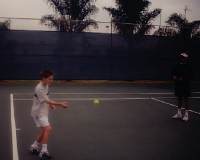 "Heels
up, feet moving, before I send ball to you."
"Heels
up, feet moving, before I send ball to you."
Drill: Play a game of toss-and-catch. From
the service line, on the same side of the net, instructor tosses balls,
on the bounce, to the student, on the baseline. (1) Jog, slowly, in place,
before first toss; (2) Cross over for first step to ball, then run; (3)
Catch ball with hand nearest ball. Watch it into hand, then look at it;
(4) Underhand toss back to instructor, in air; (5) Push off, slide back
to center. Toss side to side. Toss randomly side to side. Toss randomly
side to side, up and back. (Check to see that his foot strikes the ground
lightly--at a 45-degree angle.)
Lesson: How the racquet is held determines its use.
"The grips determine the type of shots, and spins,
that you can develop--they define your style of play."
Forehand grip--base knuckle
of finger #1 aligned with flat edge #3; heel of the palm aligned with flat
edge #3. A space between fingers #1 and 2.
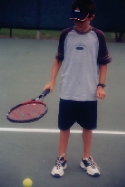 Drill:
Bounce ball down, using as little racquet head movement as possible. "Donít
swing--just touch it."
Drill:
Bounce ball down, using as little racquet head movement as possible. "Donít
swing--just touch it."
Drill: Against a wall, tap ball, allowing
it to bounce. "Your homework--youíll be tested next lesson."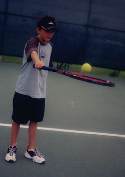
Backhand grip--Base knuckle of finger
#1 aligned with edge #2; heel of the hand aligned with edge #2. A space
between fingers #1 and 2.
Drill: Maintaining straight
arm, dribble ball up. When elbow bends, stop, start again. "How many
can you make in a row?"
Drill: Against a wall/backboard,
tap ball, allowing it to bounce once.
Lesson: In a ready position, hold the racquet, loosely,
with a continental grip.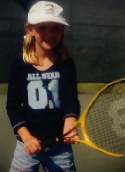 "Now
youíre relaxed, prepared to hit any shot." (Waiting with a continental
grip insures that the young student will not, over time, change his forehand
grip
"Now
youíre relaxed, prepared to hit any shot." (Waiting with a continental
grip insures that the young student will not, over time, change his forehand
grip
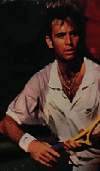 from
eastern to western. Plus it facilitates grip-changing.)
from
eastern to western. Plus it facilitates grip-changing.)
Left hand cradles throat of the racquet, at the neck;
fingers spread; thumb on top. Head of the racquet held slightly above
wrist. Arms down, comfortably straight.
Habit: Open hand on early backswing.
"The
timing of it: openÖthen squeeze."
Lessons: Contact the ball in front (The essential
habit, to be created in the first lessons). Eyes glued to the point-of-contact
until you complete the stroke. 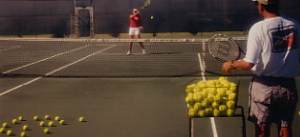 "Itís
a matter of concentrating on the stroke until itís over-then lookto see
where the ball went."
"Itís
a matter of concentrating on the stroke until itís over-then lookto see
where the ball went."
Drill/game: Playing within the service
boxes, feed soft short balls to student, (who aims at a cluster of balls
placed away from the sidelines). "Make the ball rise over the net, softly,
into the service box. Let the racquet do the work--muscles stay flaccid,
the grip relaxed. A short backswing, a gentle tap, a small follow-through."
(1) Alternate backhand and forehand, side to side; (2) Alternate fh and
bh, up and back; random fh and bh, up and back; (3) Make drill a game:
make 3-5 consecutive shots, win a point; miss before specified #, lose
point; 4-point games.
Lesson: Simple, small (and early) backswing; long (and
forward) follow-through.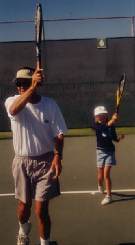
Drill: Standing 10-15 feet in front
of the student, demonstrate the groundstrokes--while he imitates--emphasizing
the timing of pivot on the count of one, pause on two, swing
on three, recover on four. (1) Draw the racquet back with
the left hand; (2) With racquet head slightly above the wrist, pause on
two; (3) Turn head into point of contact; (4) Lengthen stroke. "The
concept is forward."
Shadow Practice: Take
turns walking through the strokes (call it shadowing)--have student shadow,
then shadow together. This four-count rhythm addresses the inherent rhythms
of tennis (count aloud): "Oneótake the racquet back; two--pause; three--strike
the ball; four--follow-through and recover."
Routine: Feed it w/topspin; use racquet
to catch it, w/underspin. "Open face, block it, bounce it down, catch
it w/your racquet."
Backhand Drill: On count of one, prepare
the racquet by drawing it back?--with both hands. (For two-hander), slide
hand down on count of two. Strike ball on the count of three. After demo
and shadowing, toss balls side to side, but only after the student makes
the initial shoulder turn.
Lesson: Hit Against the Wall "A
test of your skill development." The backboard offers the ultimate
challenge--of grip changing, footwork, flexibility of strokes, racquet
control. Level I: Just tap the ball, standing no farther than fifteen feet
from the wall. Level II: Take a full stroke, from at least thirty feet.
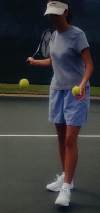
 Lesson:
On forehand, keep left hand down, still, during stroke.
Lesson:
On forehand, keep left hand down, still, during stroke.
("Itís a matter of focusing on the point-of-contact,
and first going forward, not up.")
Drill: Starting with two balls in
left hand, student feeds one (hit out of the air) into backhand corner,
holding the second ball, still, at waist level. "Aiming for the corner,
hit it as hard as youcan control it, then hold your finish until the ball
bounces."
Drill: Forehand rally, holding ball
in left hand, motionless.
Lesson: See the ball, see me, see the court--anticipate.
"Now
that you have a working knowledge of the strokes, develop some court sense."
Drill/game: Instructor stands in no-manís
land--not moving, tethered to middle of the court--feeding balls to student.
Explain "rules" of the game: (1) Short ball to instructorís forehand may
result in putaway; (2) Deep ball to instructorís feet may result in short
ball; (3) First ball must be hit to center of court; (4) If studentís first
ball is effective, second ball can be put away.
The student gains perspective as to
where the court is. He discovers that his deep shot may elicit a mistake
or a short ball, which he anticipates. With the instructor standing in
the center, he can put the ball away, by using angles. A variation: the
instructor stands inside the service line, volleys the ball back to the
student, encouraging him to win the point by passing or lobbing (instructor
cannot step behind the service line).
Lesson: Make contact at waist level. "When you
contact the ball in the strike-zone, itís easier to make solid contact,
and to hit effective shots."
Drill: For better footwork, instructor
feeds balls randomly, high and low, side to side, all softly. Student plays
all balls on-the-descent, at waist level. (Provide an example: standing
in front of student, during which he imitates.)
ShortCourt game: Played within both service boxes,
the rules: (1) SoftTennis; (2) No volleys; (3) 1st ball hit crosscourt.
Drill: Feeding short balls side to
side, student hits crosscourt into the corners of the service boxes (where
youíve placed a cluster of balls). Also: chip down-the-line, crosscourt;
topspin cc and dtl; drop shot cc, dtl. "Youíre a magician--your spin
makes the ball perform tricks."
Lesson: Make the Ball Rise Over the Net
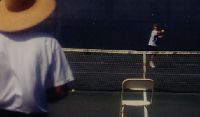 Drill:
To gain greater perspective of the court, to learn how to produce low-to-high
drives (and angles), place a chair at the service line. Student hits balls
over, around chair. "No lifeless shots?--makeyour ball rise as it clears
the net, then bound forward." Play games: 1. Hit the chair, replay
the point; 2. If student makes a particularly good play, but misses putaway,
replay the point (he gets credit for good intentions); 3. Occasionally
miss, intentionally, whenever student makes a good shot (you must reward
him).
Drill:
To gain greater perspective of the court, to learn how to produce low-to-high
drives (and angles), place a chair at the service line. Student hits balls
over, around chair. "No lifeless shots?--makeyour ball rise as it clears
the net, then bound forward." Play games: 1. Hit the chair, replay
the point; 2. If student makes a particularly good play, but misses putaway,
replay the point (he gets credit for good intentions); 3. Occasionally
miss, intentionally, whenever student makes a good shot (you must reward
him).
Drill: Drop shot-and-lob combo. A
good way of developing ball control and court sense. Teach student how
to produce a soft slice--with a short backswing, downward motion and short
follow-through. Then practice low-to-high lobs (where the apex is directly
above net player). Then feed a short ball, student drop shots, instructor
chases down ball, then student lobs or passes. "Youíre so wily!"
Lesson: Have a purpose for that shot.
Drill: To help him concentrate, to have a plan
for each shot, describe each of his shots, after the fact: "Backhand
down-the-line, forehand angle, offensive lob, drop shot, I have no ideaÖ"
King-of-Court Approach game:
From backhand corner, feed short ball to attacker, who may choose from
the following: approach down-the-middle, drop shot, lob-and-come in, first
volley (or drop volley). Defender must wait in no-manís land, may not pass
or lob on first ball (specify that he must play first ball back to the
middle).
"Youíre learning to play with cleverness--not like a robot."
Halfcourt-Fullcourt Canít-Volley
game. The ball must bounce. Student develops court sense by varying depth,
pace and spin. "Iíll let you figure out how to play the game."
Lesson: Make the Lob Elliptical
"The lob doesnít go up, it goes forward, then up--it sneaks over his head."
Drill: After placing a chair or ball
basket a couple yards from the baseline (to provide perspective), feed
balls from the net, encouraging student to make low-to-high shots that
barely clear your outstretched racquet. "What we want are low lobs that
sneak over my head, then land in the back of the court." Feed
balls randomly, short and deep.
Drill: Practice lob volleys to chair/target.
Demonstrate short stroke with open racquet face.
Feed ën volley game: From no-manís
land, on half-court, one player (attacker) feeds short ball, jogs in; (defender)
returns ball to middle; attacker practices lob volley, defender makes elliptical
lob--then play point out. First-to-5-pt. Games; switch roles.
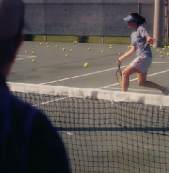 Lesson:
Add a little topspin to that forehand.
Lesson:
Add a little topspin to that forehand.
Drill: Standing ten feet from the
net, student self-feeds topspin forehands, making contact from below net
level. (He may need for you to take his hand and walk through the stroke.)
When he can routinely make the ball dip into, the court, feed him low balls.
Lesson: What you aim at is what you hit. "Soft,
short and ineffective is beneath your potential--make the ball go somewhere."
In-the-alley drill: Demonstrate/explain three basic
shots: down-the-line drives, soft angles and offensive lobs. To get the
ball out of the center of the court, ask student to direct his shots into
the alleys. "For angles, hit the outer half of the ball; for down-the-line
shots, make a long, inside-out stroke."
(1) Practice down-the-line drives,
into the alleys. Make ball rise, land behind service line. (2) Practice
soft short angles, into the alley. (3) Practice low-to-high (offensive)
lobs. Instructor feeds from service line, ball peaks above his head, directed
to target (a ball basket or a chair--the visual target gives the student
some perspective as to where the court is). (4) Rally from backcourt,
student choosing one of three shots. "Up and back and side to side??you
got me on the end of a string."
Lesson: Make a long/forward stroke. The wrap-around-the-neck
follow-through may promote a short stroke,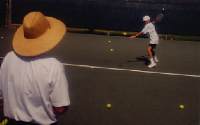 soft, loopy strokes, and poor tennis "posture." Better to teach length--to
the strokes, to the shots.
soft, loopy strokes, and poor tennis "posture." Better to teach length--to
the strokes, to the shots.
Drill: Inside-out forehand, inside-out
backhand. 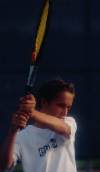 Toss/feed
balls to the center of the court, encouraging student to hit inside-out
forehands and backhands. (Place a line of balls on the court.) "Get
the hand to follow the flight of the ball."
Toss/feed
balls to the center of the court, encouraging student to hit inside-out
forehands and backhands. (Place a line of balls on the court.) "Get
the hand to follow the flight of the ball."
Lesson: Put a little underspin on the volley--to make
it stay down. "Hands in front, racquet back on the count of one,
racquet head up at finish."
Drill: Standing in front of student,
walk through volleys and overhead, while he imitates. (If needs be, take
his hand and lead him through the stroke.) Then ask him to demonstrate.
Correct and repeat. Correct and repeat, etc.
Drill: Across the court, from a distance
of ten feet, toss balls to volleyer, who taps ball back.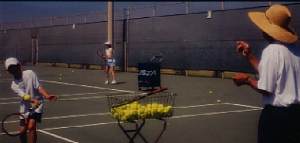
Game: On court, play a lead-up game:
balls that land in front of you, with underspin, earn a point; behind you
result in a lost point.) Occasionally toss up a lob, which he catches with
free hand, after drawing racquet back. Hold finish position for count of
two, racquet head up. (1) Forehand??finger tips facing target.
(2) Backhand--knuckles facing target. (3) Take a bold
step forward. (4) On overhead, pull racquet straight back, with left hand.
Drill: From service line,
feed low volleys to student, who volleys from below net level. "Make
volley first land at service line, second bounce near baseline."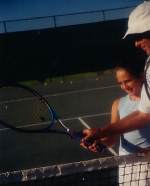
Feed-and-volley game: On half court,
from no manís land, feed an approach, walk/jog in, defender plays 1st ball
to middle, then play out point. "Learn how/when to split step, first
volley, half-volley, chip and drive."
Lesson: Grip Changing He needs some practice making
transition from backcourt to forecourt. "After making forehand approach,
and before split-step, change to your volley grip."
Drill: Feed combo of short forehand-forehand
volley. I do this drill w/in (one) service box. 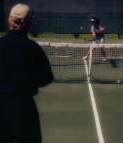 To
finish sequence, toss up a lob, which he returns w/a passing shot, or another
lob.
To
finish sequence, toss up a lob, which he returns w/a passing shot, or another
lob.
Drill/game: Play all-court tennis
w/in service box. Feed short ball to student, who approaches (makes grip
change), then play point out within box. Keep score, encourage first volley
depth, angles, drop volleys.
Lesson: Midcourt Decisions "You gotta decide
whether to volley, half-volley or hit a groundstroke."
Drill: Position student just behind
service line, then randomly feed deep, short, soft and hard balls. "Back
up on the short soft ball, hit a groundstroke; moveup on the high soft
ball, to volley."A see-how-many game: student directs his shots
into one of four squares (service boxes, backcourt), without hitting two
in a row to the same square. Make six, get a point.
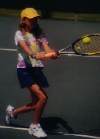
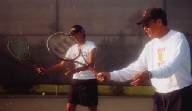
Lesson: Slice ball---for effect, for defense, out
of necessity.
Drill: After a demonstration, and
shadow practice, feed shoulder-high bouncing balls to studentís forehand.
"High
to low, stop the follow-through with palm facing net, racquet head above
wrist. Make the ball stay down, bounce at service line."
Drill: Run forward for short low backhand,
chip down-the-middle, hold straight-arm follow-through (and let go with
left hand) until ball bounces twice.
Lesson: Use open-stance footwork for wide balls, inside-out
forehands, etc. "An open stance gets your body
out of the way for certain shots." 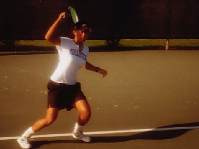
Drill: Demonstrate and imitate. Then
feed wide balls to forehand, to hit open-stance. Then running forehands.
Inside-out forehands. Running backhands.
Drill: For wide, low a/o short
forehands, demo/imitate vertical lift, where finish is over right shoulder.
Lesson: Play the ball early (half-volley, on the
rise, at the top of the bounce). "For example, when the ball comes high,
and deep, with topspin, itís better to take it on-the-rise."
Drill: Self-feed half-volleys with
instructor. "On backswing, drop racquet straight down; hit a flat ball;
shorten follow-through."
Full-Court, Half-Court game:
From no-manís land, player loses point if he steps behind the baseline.
(Leadup: play from inside service line.) And/or play game where the point
is lost as well when the player steps in front of the service line (adds
to the fun).
Lesson: Exhale at impact. "Make a sound like this: Aaaaaahuh! The aaaaa on the backswing, the huh! at contact. Doesnít have to be loud."
Lesson: Take a deep breath. Between points, take a deep breath. Right before the point begins, before the toss, take another deep breath.
Lesson: Speed up footwork. Practice open-stance
strokes, push off, quick first step, improve quickness.
10-foot drill: From the same side
of the court as student, toss the ball side to side (at a distance of ten
feet), at rapid intervals, encouraging open-stance strokes. "Push off,
run, open stance, push off, runÖ"
20-foot drill: From opposite side
of net, feed side-to-side groundstrokes. (Volleys too--"And no lunging!")
Lesson: Be deliberate, w/good intentions. "That was a good mistake."
Lessons: Pick up netted balls. Stop long ball from hitting fence (with racquet). Tap long serve into net. Return close balls, then make out call.
Lessons: Move with balance, improve strokes, try harder.
Itís called Scramble:To teach
anticipation, footwork and balance, feed balls randomly. Rule: balls must
be played at waist level. Student chases down drop shots, scrambles back
for lobs, runs wide for groundstrokes. With a group, stay in until missing,
or netting a ball a/o missing wide, or hitting short of service line (depending
on level). Whenever possible, involve players of all levels, to provide
inspiration.
Lesson: On the serve, swing weight (of the head) of
the racquet. 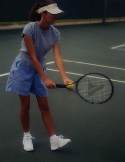
Drill: Start with hands down, racquet
cradled in fingers of tossing hand, loose grip, weight back. "Down and
up and catch and hold. Racquet poised high, directly over the head."
Insist on a spinless toss. "Note that the hand is turned sideways, so
the wrist does not flick the ball up, spinning."
Drill: Student begins the serve with
the racquet held high above the head, arm relaxed, elbow at 110-degrees
to net), racquet held in the fingers, continental grip loose. "Feel
the balancing point, let the racquet head fall like dead weight, then throw
it up at the ball. Donít try to try."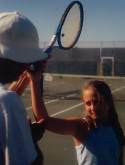
Hold finish ëtil ball bounces twice, balanced, toe of
back foot in contact with ground, evidence of wrist snap.
Drill: Practice the kneeling serve.
From no-manís land, back knee on the court, left foot forward, grip choked.
"Hit
the ball up and forward, eyes remaining at point of contact until ball
bounces. Youíre learning how to hit on the ball up to make it go down."
Drill: Practice the three-finger serve.
Hold the knob of the handle with three fingers, then hit 1/4-speed serves.
"Just
let the weight of the racquet head do it."
Drill: Practice serving from no-manís
land. Trying, desperately, to get the ball in the box, puts the new player
into a tense, white-knuckled state. Focus instead on technique--and how
to relax.
Lesson: Stand up on return of serve. "Get comfortable
taking the return at the top of the bounce,or on the rise. Shorten the
backswing, take three steps, the last one forward, then hit a line drive."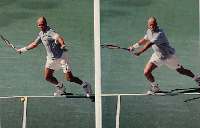
Lesson: Concentrate at a higher level. A ten-point feeding game: crosscourt and down-the-line shots earn a point; mistakes = minus point; bonus point for winner. "Practice making, not missing shots."Play games w/beginning student w/rules: (1) you canít run; (2) bonus point for winners; (3) penalty point for unforced netted error; (4) replay long error. "What was the point of that shot?" Structure points--think in combinations. Ex: wide slice serve followed by inside-out forehand. "Focus less on winning and more on playing well."
Lesson: Use the racquet to stop the ball, and to pick
it up off the court.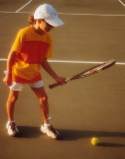
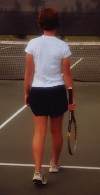 "Itís
not baseball--use your racquet!"
"Itís
not baseball--use your racquet!"
Drill: Choke up, lay the wrist back, hit the ball
with the top half of the strings, firmly the first time, softly the second.
Lesson: After point ends, slide hand up handle, holding
racquet loosely, with a continental grip. "To relax hand, keep grip
dry. Plus you donít want to look like a hack."